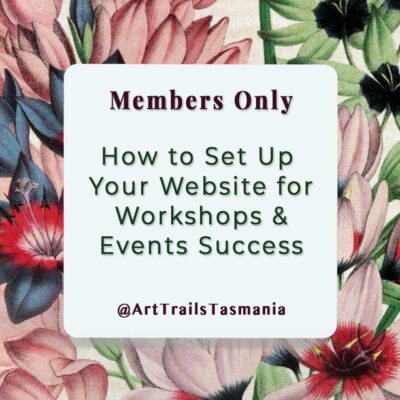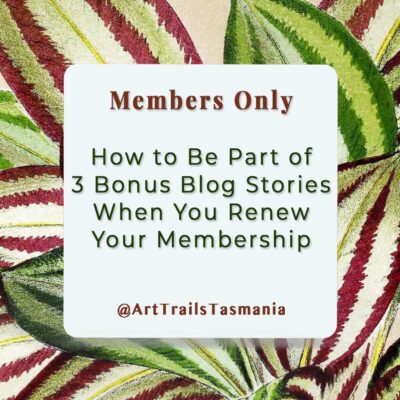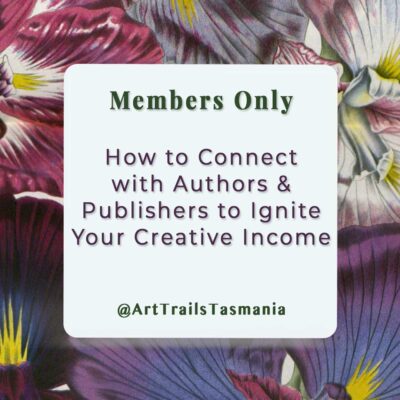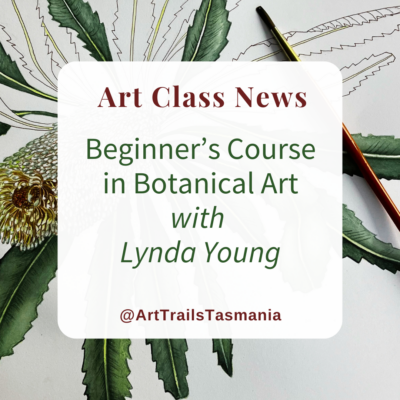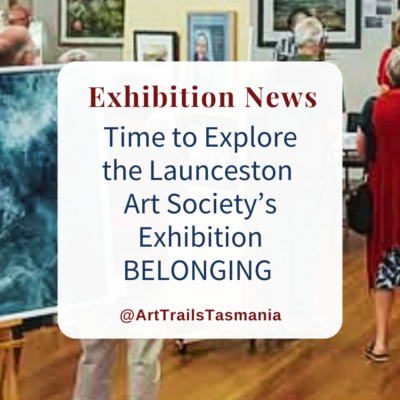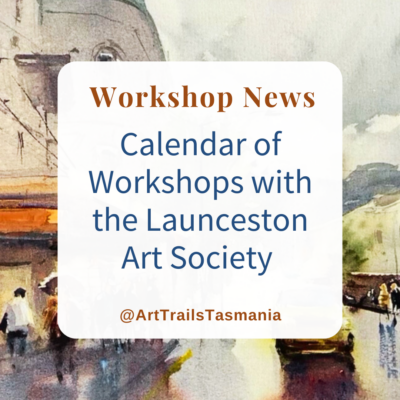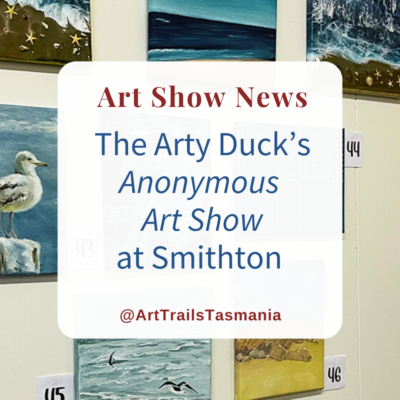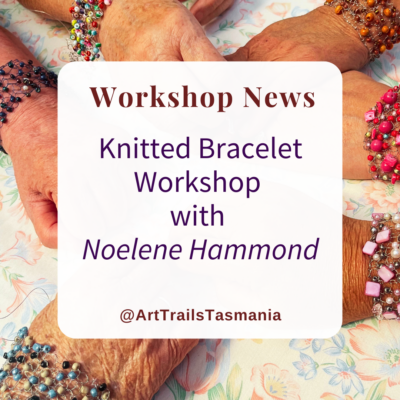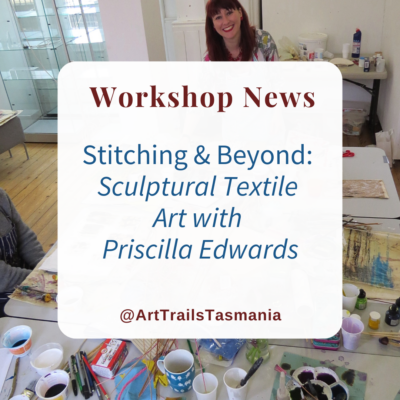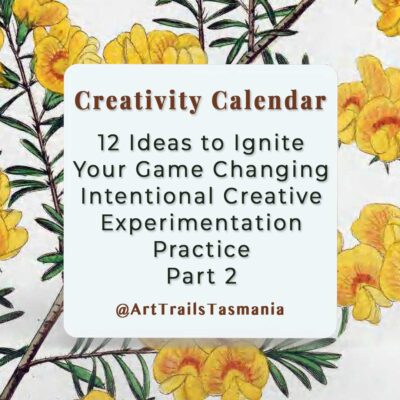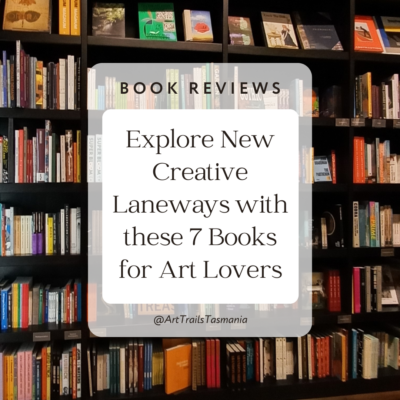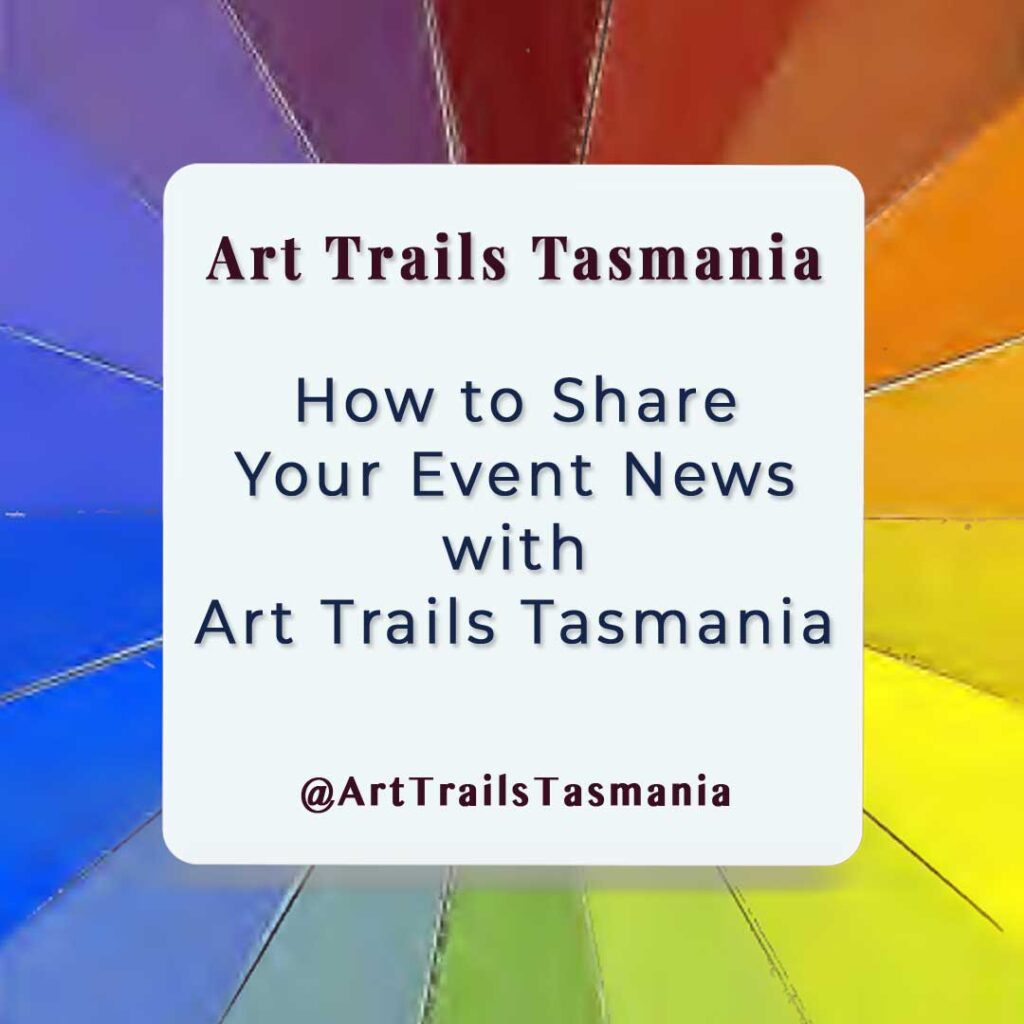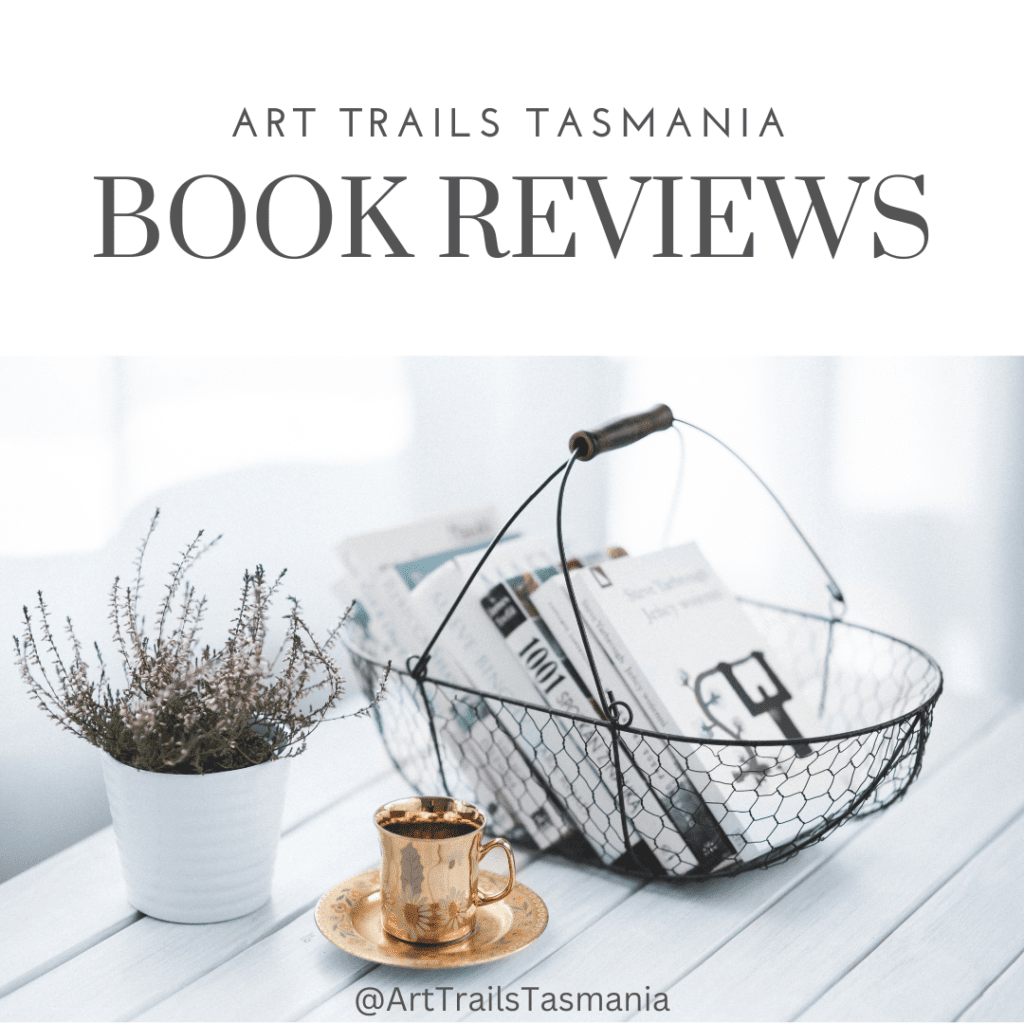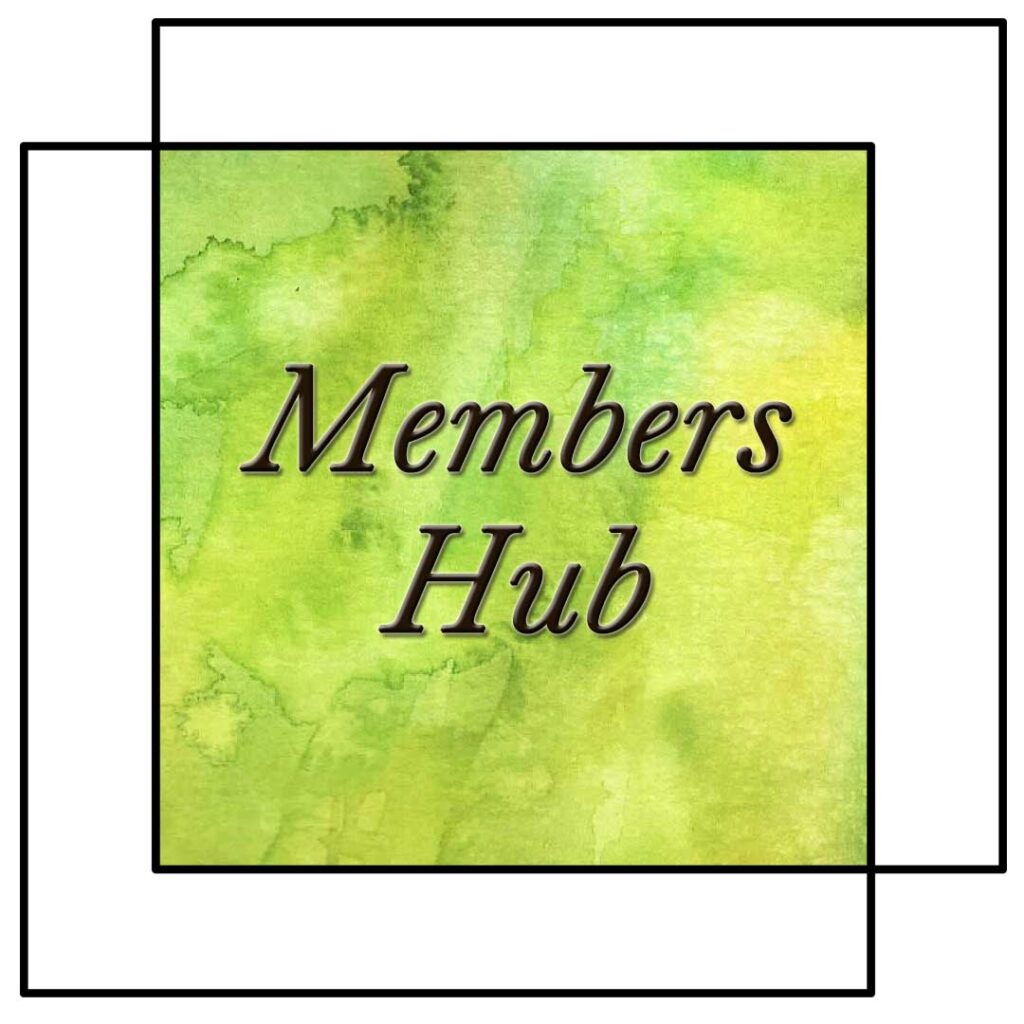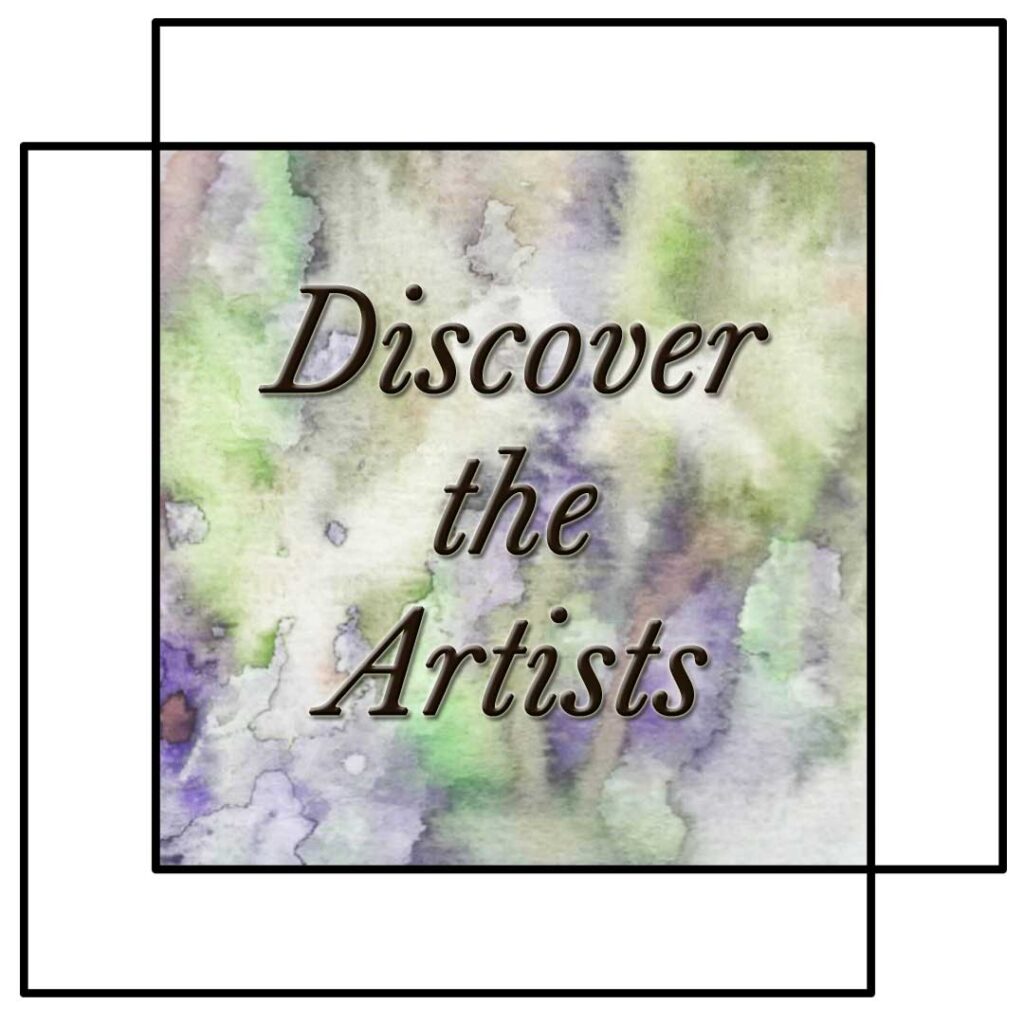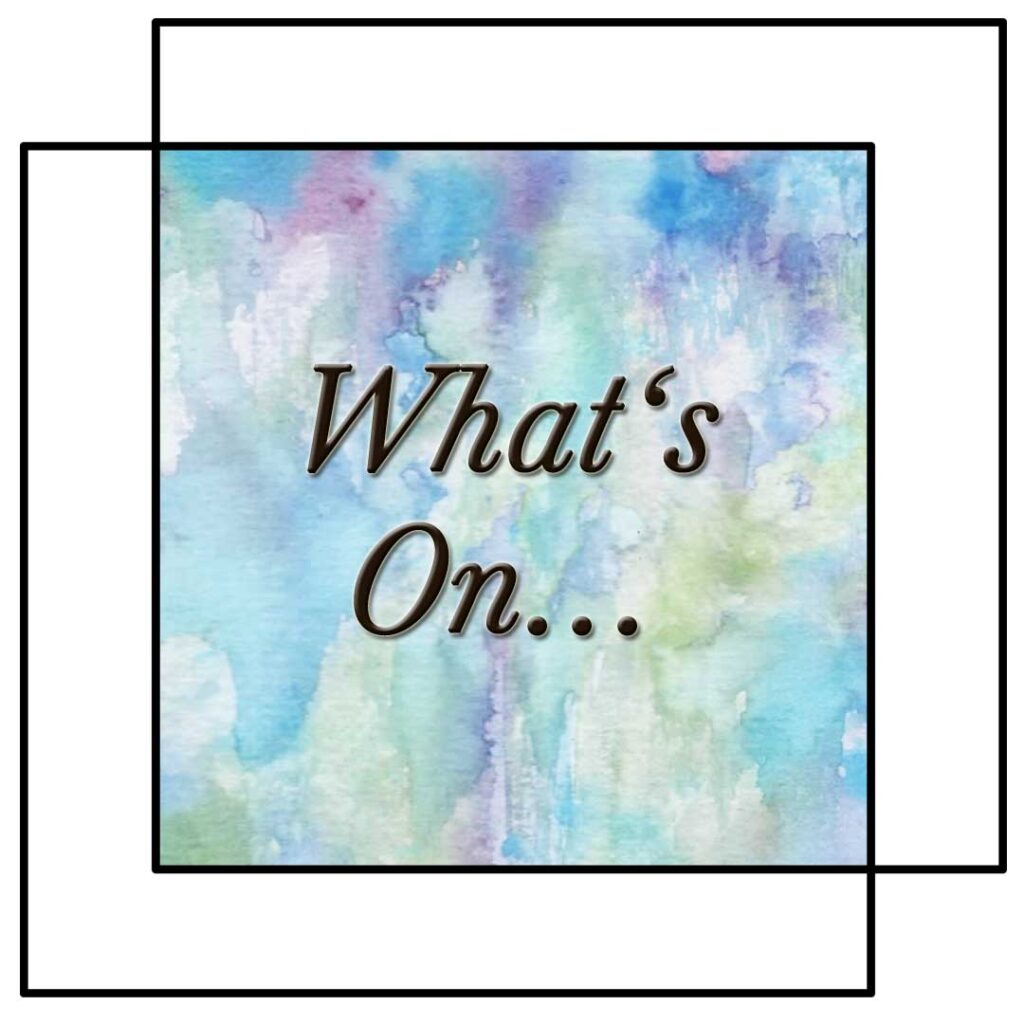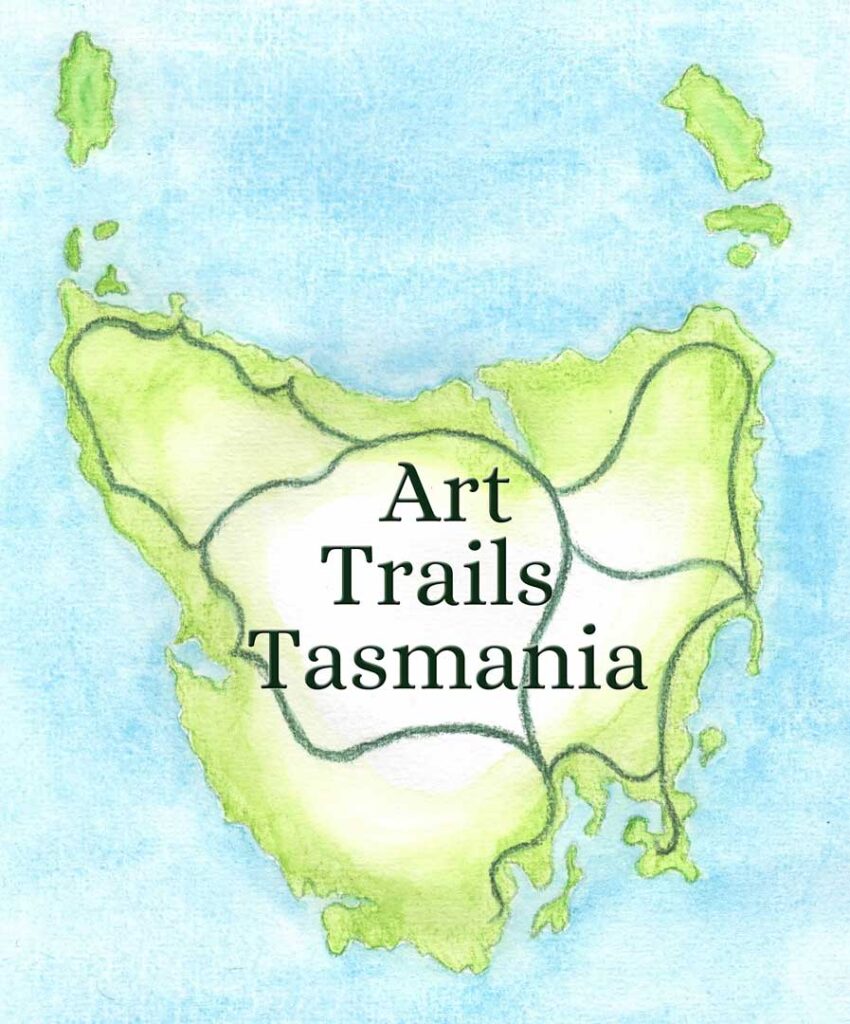Finding Joy in Restful Creativity
Creativity does not thrive on constant motion; it flourishes when given space to breathe. Rest is not absence, but a quiet resource that renews energy, focus, and imagination.
Where Part 1 explored how boredom, sleep, and daydreaming nurture the creative mind, this companion piece offers twelve practical rituals that turn rest into fertile ground for artistic growth.
These practices are intended to be lived slowly, integrated gently, and tailored to Tasmania’s landscapes — from the damp hush of rainforests to the bright clarity of coastal light.
Each ritual offers a way to pause with purpose: moments where the senses, body, and imagination find harmony. They encourage playfulness, creative mindfulness, and the joy of making without expectation.
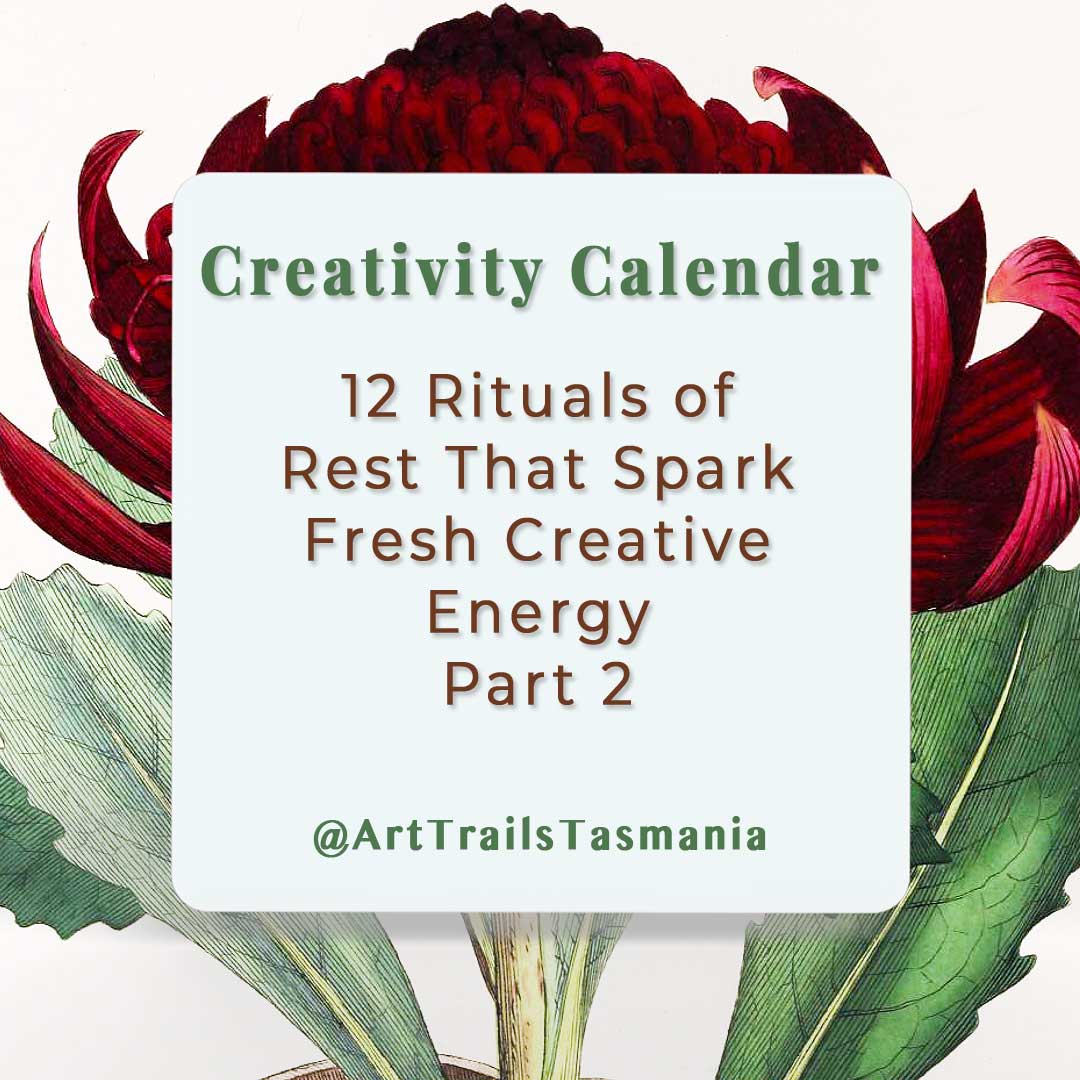
12 Practical Rituals to Explore Your Creativity
Here are 12 creative rituals for you to make your own:
1. Nature Journalling on Slow Walks
A slow walk becomes a moving meditation when combined with a sketchbook. Wander without hurry through a favourite patch of bush, a beach track, or a local garden.
Instead of counting steps or distance, attend to rhythm — the crunch of gravel, the rustle of leaves, the scent of blue gums.
Pause often to observe closely: a feather caught in grass, the spiral of a shell, a shadow pattern on bark.
Open the sketchbook and record what draws attention.
It might be a quick contour sketch, a splash of colour, or a few words describing texture or movement.
Allow imperfect marks; let curiosity lead. Nature journalling turns the outer landscape into a mirror for the inner one.
Over time, the pages fill with reminders of small wonders — a personal archive of sensory moments that quietly feed the creative spirit.
2. Blind Contour Sketching
Choose a small object — a seed pod, pebble, or flower — and place it before you.
Fix your eyes on the subject and, without looking at the page, let your pencil trace its outline in a single continuous motion.
Resist the urge to peek or correct. What emerges may look awkward, even comical, but that’s the beauty of the exercise.
Blind contour drawing teaches surrender and attentiveness. It shifts focus from results to the pure act of seeing.
This ritual dissolves stiffness in the creative hand and reminds artists that observation, not precision, is the heart of expression.
Repeating it regularly develops trust in the line itself — each curve and wobble becomes evidence of genuine looking.
Over time, this small act of discipline restores the beginner’s joy, where discovery outweighs outcome.
3. Five-Minute Creative Experiments
Creativity often thrives within small, well-defined limits. Set a timer for five minutes and give yourself a prompt such as “lines only”, “contrast”, or “movement”.
Choose any medium — pencil, collage scraps, ink, or watercolour — and start. The time pressure silences the inner critic and invites spontaneity. When the timer sounds, stop.
This ritual is a playground for the imagination.
Because the commitment is brief, experimentation feels safe; mistakes lose their weight.
Regular five-minute sessions keep creative muscles supple between larger projects.
Over weeks, these quick studies accumulate into an archive of textures, colours, and compositions that may later spark bigger ideas.
Above all, this simple ritual celebrates play — a reminder that joy and curiosity are the natural states of a healthy creative practice.
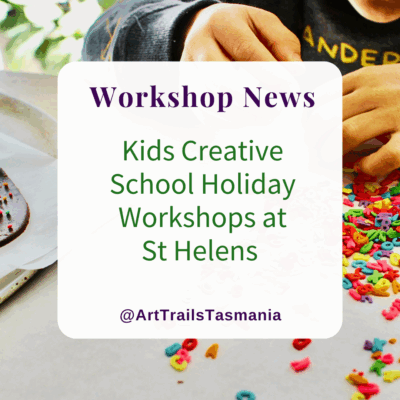
Kids Creative School Holiday Workshops at St Helens
Creative workshops are the ideal way to make school holidays fun & memorable, opening doors to new skills, connections & joy! Even better, they’re at St Helens!
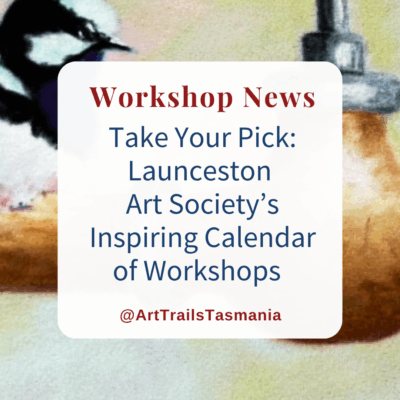
The Launceston Art Society Calendar of Workshops
Take your pick from this exciting and creatively stimulating workshops calendar being hosted by the friendly Launceston Art Society and explore your creativity.
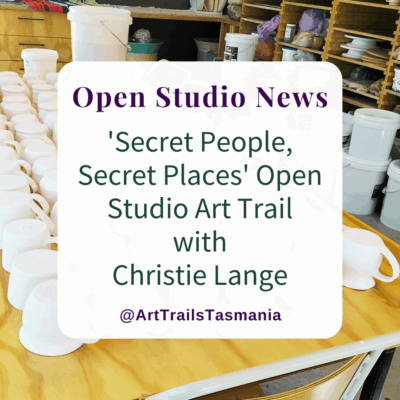
“Secret People, Secret Places” Open Studio Art Trails with Christie Lange
Discover ceramic artist Christie Lange’s open studio during “Secret People, Secret Places” at the Bay of Fires Winter Arts Festival at Binalong Bay & explore the creative process.
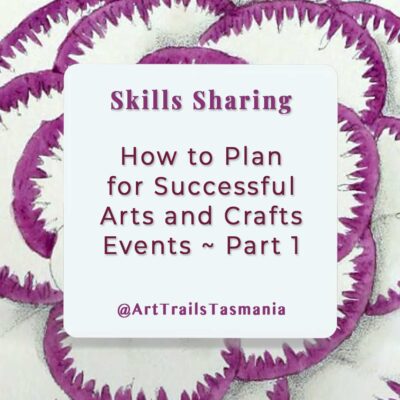
How to Plan Successful Arts and Crafts Events
Running successful arts and crafts events can be a game changer for all involved, in part 1 we look at what is involved and how to achieve your goals easily.
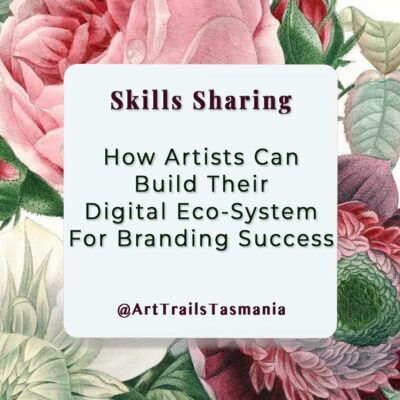
How Artists Can Build Their Digital Eco-System for Branding Success
Learn how artists create a cohesive digital eco-system with effective branding to enhance their online presence and engage audiences across multiple platforms.
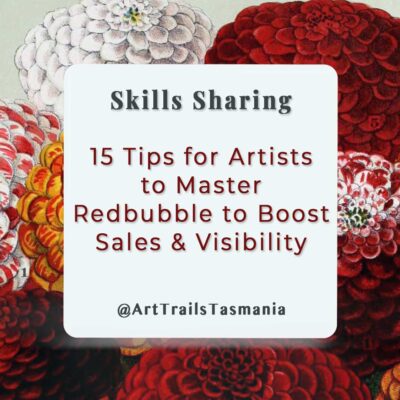
15 Tips for Artists to Master Redbubble to Boost Sales & Visibility
Here’s 15 ways how to to Flourish on Redbubble: Create, Sell, Connect! In this latest Skills Sharing story by Art Trails Tasmania
4. Creative Mindfulness: Listening with the Eyes
Find a still spot — perhaps a veranda, riverside, or shady tree.
Sit quietly and soften your gaze toward one area of the landscape. Rather than labelling what is seen, let the eyes rest as if listening.
Notice how light alters colours, how wind stirs patterns, how edges blur when attention relaxes.
This form of creative mindfulness teaches presence through looking. It anchors awareness in sensory experience rather than analysis.
Over time, such gentle attention seeps into drawing, writing, or crafting; perception becomes more nuanced, responses more intuitive.
Practised regularly, creative mindfulness it quietens mental chatter and restores focus. The world becomes richer, and in that richness, creativity reawakens — not forced, but invited.
5. Dream-Seed Journalling
Dreams are natural collaborations between imagination and rest. Keeping a notebook beside the bed allows fleeting images to be caught before they fade.
Upon waking, jot down fragments — colours, words, feelings, odd scenes. Resist editing or interpretation.
Over days and weeks, these scattered notes accumulate into a dream-seed journal: a collection of symbols that can later find form in sketches, stories, or designs.
Revisiting them offers surprising insights; recurring themes might whisper about new creative directions.
Even the act of recording deepens connection with intuition.
Dream-seed journalling reminds artists that rest continues to work quietly on their behalf, weaving unseen patterns that later blossom into tangible ideas.
6. The “No-Goal” Making Session
Allocate a stretch of uninterrupted time — perhaps an hour — to create without purpose.
Choose materials that feel inviting and begin without a plan. Follow impulse: make marks, tear paper, arrange objects, apply colour freely. The aim is to experience the process rather than produce an outcome.
In a world obsessed with results, the “no-goal” session feels liberating.
It dismantles pressure and rekindles curiosity. The mind rests because there’s nothing to achieve, and in that space, genuine exploration emerges.
Many artists rediscover playfulness through this approach — the kind that first sparked their love of making.
Some sessions yield accidental beauty; others end in mess. Both are equally valuable, for each session restores confidence in instinct and the joy of creation itself.
And it can be a surprisingly practical path towards revealing your own creative voice.
7. Micro-Rests in the Studio
Sustained focus can quietly drain energy, even when enthusiasm is high.
Introducing micro-rests within studio time preserves vitality.
Every 30–45 minutes, set tools down, close the eyes briefly, and take three deep breaths.
Look out a window, stretch hands, or step outside for a moment of sunlight.
These pauses recalibrate attention and prevent burnout.
They remind the body and mind that creativity benefits from rhythm — exertion balanced with ease.
Artists who incorporate micro-rests often notice more sustained flow and fewer mistakes.
Over time, the practice builds resilience; creativity becomes less a sprint, more a steady dance between action and recovery.
8. Seasonal Foraging and Material Play
Tasmania’s shifting seasons offer abundant materials for creative rest.
After rain, the ground gleams with leaves, twigs, and stones; in winter, the coast reveals shells and driftwood. Foraging is best done slowly and respectfully — take only what has already fallen.
Lay collected items on a workbench or windowsill. Let them remain there for days, perhaps weeks, without immediate use.
Observe how shapes and colours change as they dry or fade. Later, they might become printing plates, inspiration for textures, or the starting point for a sketch.
The act of gathering connects body and place, and the waiting period teaches patience. Creativity here grows from rhythm — a cycle of collecting, contemplating, and making.
9. Mapping the Creative Voice
A simple sketchbook exercise can clarify personal direction. Begin by choosing a word or emotion that resonates — “stillness”, “wild”, “renewal”.
Write it in the centre of a page. From that point, branch out with lines, shapes, or colours that echo the word. Add fragments of phrases, doodles, or associations that surface.
Over time, these maps form a visual diary of inner language. They reveal patterns — certain colours or symbols that repeat — offering clues about evolving themes.
This ritual encourages reflection without overthinking. It provides a restful way to engage creatively while stepping back from output.
Mapping the creative voice grounds practice in authenticity, showing that rest and reflection are integral to self-expression.
10. Visual Haiku Breaks
Keep a small poetry book or local art catalogue near the workspace. When energy dips, stop working and open it at random.
Read one short poem or study one artwork slowly, letting words or images sink in. Then, on a blank page, respond with three marks, three words, or a tiny sketch — your own “visual haiku”.
This ritual acts as a reset button for the mind.
The brevity of haiku encourages clarity, while the visual response reconnects feeling and form.
Practised regularly, it cultivates the ability to find depth in simplicity. It also bridges disciplines, allowing writing, art, and mindfulness to blend.
A single haiku break can shift mood, release tension, and restore creative rhythm within minutes.
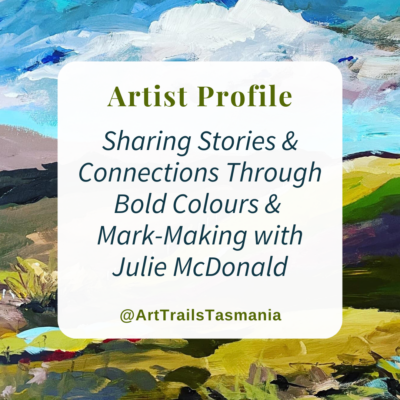
Bold Colours and Mark-Making with Julie McDonald
Thriving with bold colours, mark-making, creatively challenging herself artist Julie McDonald is coming into her own as she honours her muse.
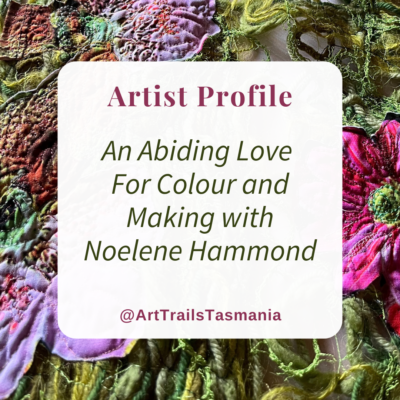
An Abiding Love for Colour and Making with Noelene Hammond
Noelene Hammand’s love of colour began in art galleries. Now, from her studio by the Tamar, she creates vibrant works with wool, beads, and bold textiles.
11. Seasonal Reflection and Sketch Exchange
At the end of each season, take an hour to revisit recent work — journal pages, sketches, photographs, or experiments.
Spread them out and look without judgement. Which ones still feel alive? Which carry quiet promise? Note these in a few lines on the back of the page or in a notebook.
If possible, exchange a few pieces with another maker — through the post, at a local market, or over tea.
Seeing one’s work through someone else’s eyes offers fresh insight. Reflection brings closure; sharing reawakens connection.
This gentle ritual of review and exchange ensures creative growth remains communal and cyclical, much like the seasons themselves.
12. Light Sketching at Dawn or Dusk
Dawn and dusk hold a softness that encourages contemplation.
Settle outdoors with a sketchbook or camera as the light shifts. Work quickly, responding to changing colours and forms. Allow imperfection; let the fading or emerging light decide when to stop.
These sessions nurture patience and humility. The transient light demands attentiveness but forbids overworking.
It invites surrender — a trust in fleeting beauty.
Repeated through the year, the practice documents the landscape’s moods and deepens connection with place.
For many, it becomes a daily meditation: a pause between sleep and activity, rest and creation, where the boundary between both gently dissolves.
This practice can be a lovely pathway to healing with creativity.
Rest as a Companion to Making
These twelve rituals transform rest into a creative ally. They work best when practiced lightly — woven into ordinary routines rather than scheduled as obligations.
Each one offers a different way to pause: through attention, touch, reflection, or play. Which ones are resonating with you? Are there variations on them that appeal?
For artists and makers, these practices align naturally with local landscapes and rhythms — sea air, shifting skies, and bush textures.
Rest becomes not a withdrawal but a listening, a moment where the mind slows enough to let imagination breathe.
When creativity is nourished by rest — by nature journalling, sketching, mindful seeing, and joyful experimentation — energy returns in fresh and surprising ways.
The voice of making grows clearer, the process becomes kinder, and the work itself begins to hum with renewed life.
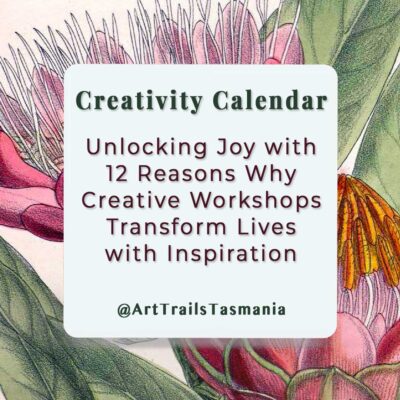
Unlocking Joy with 12 Reasons Why Creative Workshops Transform Lives with Inspiration
How art and craft workshops brings immense joy and fulfilment, serving as a vital counterbalance to the everyday grind in this Creativity Calendar Art Trails Tasmania story.
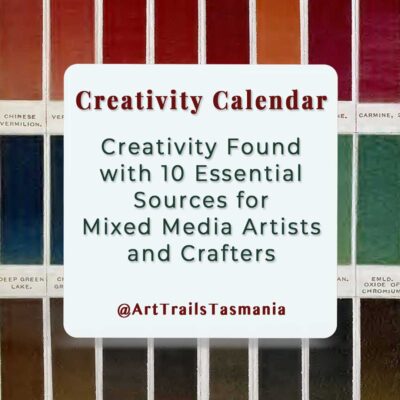
Creativity Found with 10 Essential Sources for Mixed Media Artists and Crafters
Explore the versatile world of mixed media art with 10 inspiring sources & key principles for creating rich, textured artworks for artists & crafters with this Creativity Calendar story by Art Trails Tasmania.
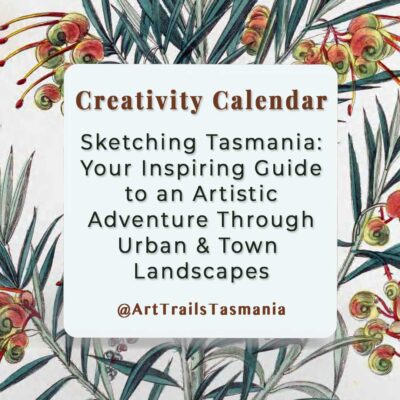
Sketching Tasmania Your Inspiring Guide to an Artistic Adventure Through Urban and Town Landscapes
Discover Tasmania’s urban charm! Your inspiring guide for urban sketchers to sketching adventures amid 20 picturesque towns and cityscapes.
Read the Latest How To Blog Stories
How to Plan Successful Arts and Crafts Events
Planning and Creating Profitable Events Arts and crafts events are essential for engaging art lovers, buyers, and followers, and making them successful requires thoughtful planning and promotion. This skills story is Part 1 of a two-part series designed to guide...
How to Set Up Your Website for Workshops and Events Success
Thriving with Workshops and Events Successfully running workshops, events, classes and online courses can be an ideal way for artists and makers to create prosperous income channels. This can be the difference between surviving and thriving. Having a stall at markets,...
How Artists Can Build Their Digital Eco-System for Branding Success
7 Ways to Grow Your Digital Eco-System with Effective Branding A cohesive digital eco-system and branding approach essential for artists, makers, creative business owners, and art groups to establish a recognisable presence across multiple platforms. Here are seven...
15 Tips for Artists to Master Redbubble to Boost Sales & Visibility
Discover Redbubble: Where Artists Thrive, Buyers Explore, Creations Shine Redbubble is an online marketplace that enables artists to sell their artwork printed on various products, including clothing, stickers, phone cases, and home decor. It's a platform for both...
How to Be Part of 3 Bonus Curated Blog Stories When You Renew Your Membership
Saying Thank You to Renewing Members with Three Curated Blog Stories As a thank you for renewing your Art Trails Tasmania membership for another year I thought being part of a series of three member focused blog stories would be a delightful gift from me to you. I’ve...
How to Connect with Authors and Publishers to Ignite Your Creative Income
How to Create an Income as an Illustrator of Books Are you eager to merge your creativity with storytelling? Illustrating books by connecting with authors and publishers offers an exciting dive into the art and literature world while also generating an income. ...
Read the Latest Blog Stories and Flourish…
Beginner’s Course in Botanical Art with Lynda Young
Learn and Grow with Botanical Artist Lynda Young The talented Lynda Young is sharing her abundant skills and insights in her latest free UA3 Botanical Art for Beginners Class. Starting Wednesday 12th February 10am-12 at Beaconsfield Community house in Grubb St. It is...
Explore the Launceston Art Society’s BELONGING Exhibition
You're Invited to attend the Launceston Art Society's BELONGING Exhibition The Launceston Art Society presents BELONGING, an exhibition exploring the deep connections we form with people, places, and purpose. Featuring diverse artistic interpretations of belonging,...
Workshop Calendar with the Launceston Art Society
The Latest Calendar of Workshops with the LAS The Launceston Art Society is delighted to share with you an inspiring workshop calendar. From acrylics to watercolour to coloured pencils, these workshops are all about developing your skills, whether they're new ones or...
The Anonymous Art Show at The Arty Duck
Discover Artists of the Ruggesd North West in the Anonymous Art Show at the Arty Duck You're invited to explore the Anonymous Art Show at the Arty Duck in Smithton. As part of the Circular Head Council's Feel Good February, artworks have been donated by local arts...
Knitted Bracelet Workshop with Noelene Hammond
Discover the Joy in Making Knitted Bracelets This is a beginners nitted bracelet lesson. Learn how to knit your own bracelet or for a special gift. You will be using wire and seed beads in this lesson it is how to use the wire and hold the beads in place. You must...
Stitching and Beyond Presents: Sculptural Textile Art with Priscilla Edwards
Indulge Your Love of Textile Art with Stitching & Beyond in this Priscilla Edwards Workshop This is a great textile art opportunity to be inspired to take your art off the wall and into the world of 3D mixed media using found items with the Sculptural Textile Art...
12 Ideas to Ignite Your Intentional Creative Experimentation Practice Part 2
12 Inspiring Ideas for Your Intentional Creative Experimentation Welcome to part 2 of our Intentional Creative Experimentation practice series! In the first instalment, we explored the concept of intentional creative experimentation, which is all about giving yourself...
Explore Creative Laneways with 7 Art Lover Books
Book Reviews for Art Lovers Explore a world of artistic inspiration through our book reviews, featuring a selection of seven must-read treasures for artists, designers, writers, nature lovers, potters and adventurers. Dive into Painting Perspective: Depth and Distance...
Bold Colours and Mark-Making with Julie McDonald
An Art Practice Centred on Sharing Connections My art practice is more than just a profession; it’s my way of sharing stories and connecting with the world around me. I thrive on experimenting with bold colours and mark-making, constantly challenging myself to step...
Read What Our Members Say About Belonging
Join the growing, supportive artists community today and have your Artist story told here.
Belinda is doing a great job creating a professional looking artist hub online. Check out the profile I posted recently to see how well she does them. To all my artist friends let’s help make this THE go to place to discover local artists.
You won’t regret joining Art Trails Tasmania . It’s a welcoming community for creatives at any career stage.Becoming an Art Trails Tasmania member wasn’t a hard decision for me to make as it’s such a wealth of knowledge and support.Being member provides a quality way to showcase your creative endeavours and it’s quickly growing in reach.
We operate a home based picture framing business and recently joined Art Trails Tasmania as a means to giving us exposure to the wider artist community. We have almost immediately seen increase in activity thru our online sites, which I am certain will lead to more opportunities to grow our business.

